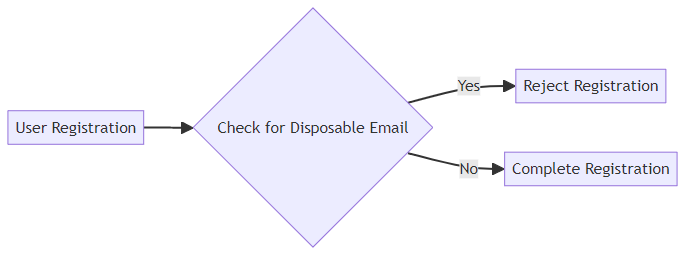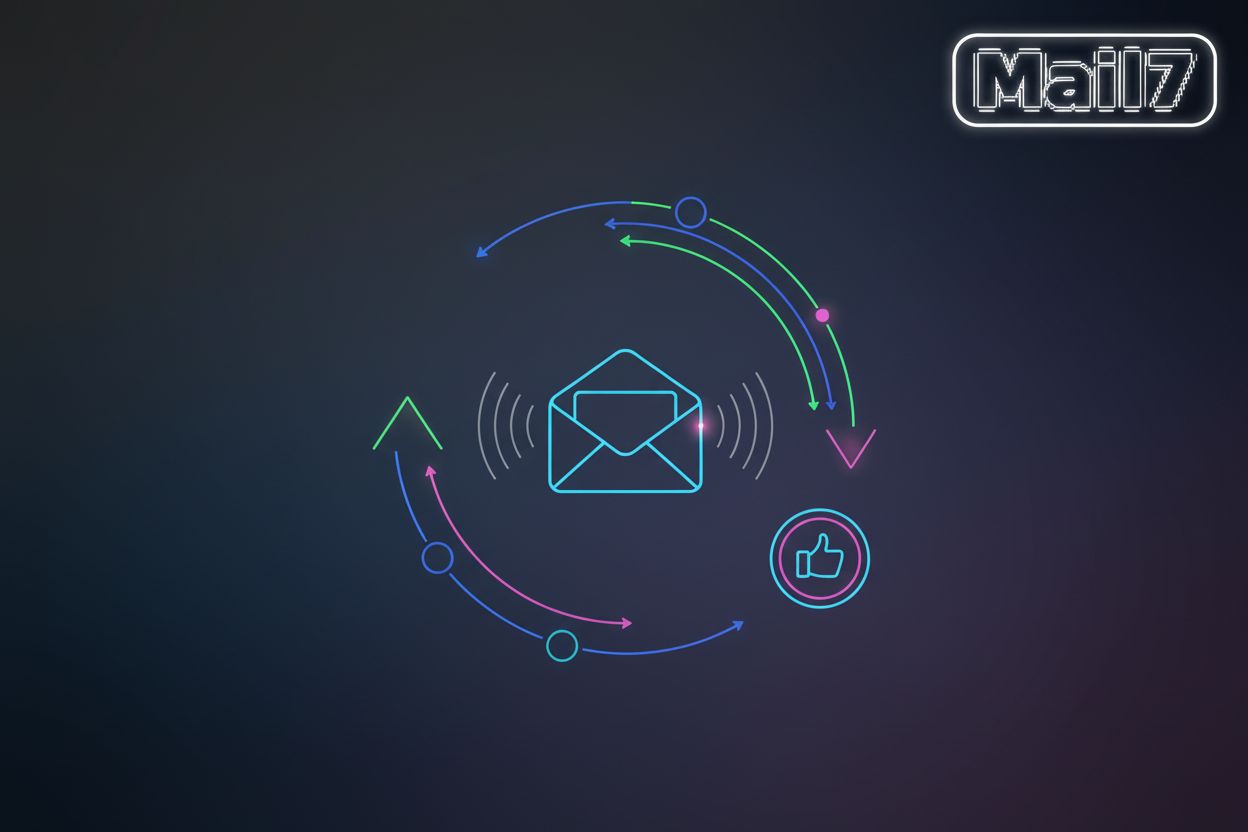Mastering Disposable Email Detection: A Developer's Guide
Understanding the Disposable Email Landscape
Did you know that disposable email addresses aren't just about avoiding spam? (A guide to making use of disposable email addresses) They're a growing challenge for developers, impacting everything from user verification to email deliverability. (How Two Major Industry Changes Impacted Email Engagement) Let's dive into the world of disposable emails and understand why they matter.
Disposable email addresses, also known as temporary emails, are designed for short-term use. Users create these addresses to avoid revealing their primary email, often to bypass registration requirements or avoid spam. These services come in various forms, from free, readily available options to paid services offering more features, and even self-hosted solutions.
- Privacy: Users want to keep their primary email private, especially when signing up for services they are unsure about.
- Avoiding Spam: Disposable emails help avoid unwanted marketing emails and newsletters.
- Testing: Developers and testers use them to create multiple accounts for testing purposes. This can be problematic because it can lead to skewed analytics, making it hard to gauge real user engagement. It also means test accounts might not behave like real user accounts, potentially masking issues in email-dependent features if the temporary emails aren't reliably accessible for testing.
Disposable emails create several headaches for developers. They can lead to skewed analytics, increased spam, and fraudulent accounts. Moreover, using disposable emails can negatively impact email deliverability and sender reputation. Imagine a healthcare platform struggling with inaccurate patient data due to users signing up with temporary emails. Or a retail company facing skewed marketing analytics because promotional offers are being abused through disposable emails.
According to AtData, disposable emails are a key tool for fraudsters, enabling them to operate without history or attachment, making detection difficult. (How Disposable Emails Enable Invisible Digital Fraud | AtData)
The abuse of free trials is a common issue. Users create multiple accounts with different disposable emails to repeatedly access free services. Another issue is the creation of fake accounts for malicious activities, such as spreading spam or engaging in fraudulent behavior. In testing environments, disposable emails can circumvent email verification processes, leading to inaccurate test results and potentially false positives in security testing.

As dev.to highlights, disposable emails lead to reduced quality of user data.
Understanding the challenges posed by disposable emails is the first step. Next, we'll explore methods for detecting and blocking them.
Traditional Detection Methods: Strengths and Limitations
Did you know that some disposable email services are so sophisticated they can mimic legitimate email providers? Detecting these temporary email addresses requires a multi-faceted approach. Let's explore some traditional methods and their limitations.
One common technique involves maintaining blacklists of known disposable email domains. These lists act as databases of domains associated with temporary email services. When a user registers with an email address, the system checks the domain against the blacklist.
- Strengths: Simple to implement and can be effective against well-known disposable email providers.
- Limitations: Blacklists are reactive. They require constant updating to remain effective. New disposable email domains appear regularly, making it difficult to keep up.
Maintaining an accurate and up-to-date blacklist demands continuous effort. You can source these lists from community-driven projects, commercial services, or create your own based on observed patterns. However, relying solely on blacklists provides a false sense of security.
Another method involves analyzing MX (Mail Exchange) records. MX records specify the mail servers responsible for accepting email messages on behalf of a domain. By examining these records, you can identify suspicious or invalid email servers.
- Strengths: Helps identify domains that do not have proper email infrastructure.
- Limitations: Some disposable email services use legitimate MX records. This makes it harder to distinguish them from genuine email providers.
Performing DNS queries to check the legitimacy of a domain's email infrastructure can add another layer of detection. This involves verifying that the domain has valid and properly configured MX records. However, this method is not foolproof, as some services take steps to appear legitimate.
Regular expressions (regex) can identify common patterns in disposable email addresses. For example, many temporary email services use predictable naming conventions or keywords in their domain names.
- Strengths: Can quickly identify addresses that follow specific disposable email patterns.
- Limitations: Easily bypassed by variations in email address creation. Users can create email addresses that do not match the typical patterns.
Here are some regex patterns commonly used to identify disposable email domains or structures:
- Keywords in Domain:
/\b(mailinator|tempmail|disposable|throwaway|burner)\b\.com$/i- Logic: This pattern looks for common keywords like "mailinator," "tempmail," "disposable," "throwaway," or "burner" directly within the domain name, specifically ending in ".com". The
\bensures word boundaries, preventing partial matches within other words, andimakes it case-insensitive.
- Specific TLDs often used by disposable services:
- `/.(email|xyz|online|live|me|info|biz|tech|site|store|shop|club|today|news|blog|icu|top|work|life|solutions|services|global|international|agency|company|group|team|project|design|art|photo|video|music|audio|game|app|dev|io|ai|co|cc|tv|fm|gg|vc|ly|sh|to|me|us|ca|uk|de|fr|es|it|jp|kr|cn|in|br|ru|au|nz|nl|se|no|dk|fi|ch|at|be|pt|gr|pl|cz|hu|ro|bg|sk|si|hr|rs|mk|ba|me|al|ua|by|kz|uz|az|ge|am|md|tj|tm|kg|mn|np|pk|bd|lk|mv|bt|id|my|ph|sg|th|vn|kh|la|mm|cn|hk|mo|tw|kp|kr|jp|mn|kz|uz|tj|tm|kg|cn|hk|mo|tw|kp|kr|jp|mn|kz|uz|tj|tm|kg|cn|hk|mo|tw|kp|kr|jp|mn|kz|uz|tj|tm|kg|cn|hk|mo|tw|kp|kr|jp|mn|kz|uz|tj|tm|kg|cn|hk|mo|tw|kp|kr|jp|mn|kz|uz|tj|tm|kg|cn|hk|mo|tw|kp|kr|jp|mn|kz|uz|tj|tm|kg|cn|hk|mo|tw|kp|kr|jp|mn|kz|uz|tj|tm|kg|cn|hk|mo|tw|kp|kr|jp|mn|kz|uz|tj|tm|kg|cn|hk|mo|tw|kp|kr|jp|mn|kz|uz|tj|tm|kg|cn|hk|mo|tw|kp|kr|jp|mn|kz|uz|tj|tm|kg|cn|hk|mo|tw|kp|kr|jp|mn|kz|uz|tj|tm|kg|cn|hk|mo|tw|kp|kr|jp|mn|kz|uz|tj|tm|kg|cn|hk|mo|tw|kp|kr|jp|mn|kz|uz|tj|tm|kg|cn|hk|mo|tw|kp|kr|jp|mn|kz|uz|tj|tm|kg|cn|hk|mo|tw|kp|kr|jp|mn|kz|uz|tj|tm|kg|cn|hk|mo|tw|kp|kr|jp|mn|kz|uz|tj|tm|kg|cn|hk|mo|tw|kp|kr|jp|mn|kz|uz|tj|tm|kg|cn|hk|mo|tw|kp|kr|jp|mn|kz|uz|tj|tm|kg|cn|hk|mo|tw|kp|kr|jp|mn|kz|uz|tj|tm|kg|cn|hk|mo|tw|kp|kr|jp|mn|kz|uz|tj|tm|kg|cn|hk|mo|tw|kp|kr|jp|mn|kz|uz|tj|tm|kg|cn|hk|mo|tw|kp|kr|jp|mn|kz|uz|tj|tm|kg|cn|hk|mo|tw|kp|kr|jp|mn|kz|uz|tj|tm|kg|cn|hk|mo|tw|kp|kr|jp|mn|kz|uz|tj|tm|kg|cn|hk|mo|tw|kp|kr|jp|mn|kz|uz|tj|tm|kg|cn|hk|mo|tw|kp|kr|jp|mn|kz|uz|tj|tm|kg|cn|hk|mo|tw|kp|kr|jp|mn|kz|uz|tj|tm|kg|cn|hk|mo|tw|kp|kr|jp|mn|kz|uz|tj|tm|kg|cn|hk|mo|tw|kp|kr|jp|mn|kz|uz|tj|tm|kg|cn|hk|mo|tw|kp|kr|jp|mn|kz|uz|tj|tm|kg|cn|hk|mo|tw|kp|kr|jp|mn|kz|uz|tj|tm|kg|cn|hk|mo|tw|kp|kr|jp|mn|kz|uz|tj|tm|kg|cn|hk|mo|tw|kp|kr|jp|mn|kz|uz|tj|tm|kg|cn|hk|mo|tw|kp|kr|jp|mn|kz|uz|tj|tm|kg|cn|hk|mo|tw|kp|kr|jp|mn|kz|uz|tj|tm|kg|cn|hk|mo|tw|kp|kr|jp|mn|kz|uz|tj|tm|kg|cn|hk|mo|tw|kp|kr|jp|mn|kz|uz|tj|tm|kg|cn|hk|mo|tw|kp|kr|jp|mn|kz|uz|tj|tm|kg|cn|hk|mo|tw|kp|kr|jp|mn|kz|uz|tj|tm|kg|cn|hk|mo|tw|kp|kr|jp|mn|kz|uz|tj|tm|kg|cn|hk|mo|tw|kp|kr|jp|mn|kz|uz|tj|tm|kg|cn|hk|mo|tw|kp|kr|jp|mn|kz|uz|tj|tm|kg|cn|hk|mo|tw|kp|kr|jp|mn|kz|uz|tj|tm|kg|cn|hk|mo|tw|kp|kr|jp|mn|kz|uz|tj|tm|kg|cn|hk|mo|tw|kp|kr|jp|mn|kz|uz|tj|tm|kg|cn|hk|mo|tw|kp|kr|jp|mn|kz|uz|tj|tm|kg|cn|hk|mo|tw|kp|kr|jp|mn|kz|uz|tj|tm|kg|cn|hk|mo|tw|kp|kr|jp|mn|kz|uz|tj|tm|kg|cn|hk|mo|tw|kp|kr|jp|mn|kz|uz|tj|tm|kg|cn|hk|mo|tw|kp|kr|jp|mn|kz|uz|tj|tm|kg|cn|hk|mo|tw|kp|kr|jp|mn|kz|uz|tj|tm|kg|cn|hk|mo|tw|kp|kr|jp|mn|kz|uz|tj|tm|kg|cn|hk|mo|tw|kp|kr|jp|mn|kz|uz|tj|tm|kg|cn|hk|mo|tw|kp|kr|jp|mn|kz|uz|tj|tm|kg|cn|hk|mo|tw|kp|kr|jp|mn|kz|uz|tj|tm|kg|cn|hk|mo|tw|kp|kr|jp|mn|kz|uz|tj|tm|kg|cn|hk|mo|tw|kp|kr|jp|mn|kz|uz|tj|tm|kg|cn|hk|mo|tw|kp|kr|jp|mn|kz|uz|tj|tm|kg|cn|hk|mo|tw|kp|kr|jp|mn|kz|uz|tj|tm|kg|cn|hk|mo|tw|kp|kr|jp|mn|kz|uz|tj|tm|kg|cn|hk|mo|tw|kp|kr|jp|mn|kz|uz|tj|tm|kg|cn|hk|mo|tw|kp|kr|jp|mn|kz|uz|tj|tm|kg|cn|hk|mo|tw|kp|kr|jp|mn|kz|uz|tj|tm|kg|cn|hk|mo|tw|kp|kr|jp|mn|kz|uz|tj|tm|kg|cn|hk|mo|tw|kp|kr|jp|mn|kz|uz|tj|tm|kg|cn|hk|mo|tw|kp|kr|jp|mn|kz|uz|tj|tm|kg|cn|hk|mo|tw|kp|kr|jp|mn|kz|uz|tj|tm|kg|cn|hk|mo|tw|kp|kr|jp|mn|kz|uz|tj|tm|kg|cn|hk|mo|tw|kp|kr|jp|mn|kz|uz|tj|tm|kg|cn|hk|mo|tw|kp|kr|jp|mn|kz|uz|tj|tm|kg|cn|hk|mo|tw|kp|kr|jp|mn|kz|uz|tj|tm|kg|cn|hk|mo|tw|kp|kr|jp|mn|kz|uz|tj|tm|kg|cn|hk|mo|tw|kp|kr|jp|mn|kz|uz|tj|tm|kg|cn|hk|mo|tw|kp|kr|jp|mn|kz|uz|tj|tm|kg|cn|hk|mo|tw|kp|kr|jp|mn|kz|uz|tj|tm|kg|cn|hk|mo|tw|kp|kr|jp|mn|kz|uz|tj|tm|kg|cn|hk|mo|tw|kp|kr|jp|mn|kz|uz|tj|tm|kg|cn|hk|mo|tw|kp|kr|jp|mn|kz|uz|tj|tm|kg|cn|hk|mo|tw|kp|kr|jp|mn|kz|uz|tj|tm|kg|cn|hk|mo|tw|kp|kr|jp|mn|kz|uz|tj|tm|kg|cn|hk|mo|tw|kp|kr|jp|mn|kz|uz|tj|tm|kg|cn|hk|mo|tw|kp|kr|jp|mn|kz|uz|tj|tm|kg|cn|hk|mo|tw|kp|kr|jp|mn|kz|uz|tj|tm|kg|cn|hk|mo|tw|kp|kr|jp|mn|kz|uz|tj|tm|kg|cn|hk|mo|tw|kp|kr|jp|mn|kz|uz|tj|tm|kg|cn|hk|mo|tw|kp|kr|jp|mn|kz|uz|tj|tm|kg|cn|hk|mo|tw|kp|kr|jp|mn|kz|uz|tj|tm|kg|cn|hk|mo|tw|kp|kr|jp|mn|kz|uz|tj|tm|kg|cn|hk|mo|tw|kp|kr|jp|mn|kz|uz|tj|tm|kg|cn|hk|mo|tw|kp|kr|jp|mn|kz|uz|tj|tm|kg|cn|hk|mo|tw|kp|kr|jp|mn|kz|uz|tj|tm|kg|cn|hk|mo|tw|kp|kr|jp|mn|kz|uz|tj|tm|kg|cn|hk|mo|tw|kp|kr|jp|mn|kz|uz|tj|tm|kg|cn|hk|mo|tw|kp|kr|jp|mn|kz|uz|tj|tm|kg|cn|hk|mo|tw|kp|kr|jp|mn|kz|uz|tj|tm|kg|cn|hk|mo|tw|kp|kr|jp|mn|kz|uz|tj|tm|kg|cn|hk|mo|tw|kp|kr|jp|mn|kz|uz|tj|tm|kg|cn|hk|mo|tw|kp|kr|jp|mn|kz|uz|tj|tm|kg|cn|hk|mo|tw|kp|kr|jp|mn|kz|uz|tj|tm|kg|cn|hk|mo|tw|kp|kr|jp|mn|kz|uz|tj|tm|kg|cn|hk|mo|tw|kp|kr|jp|mn|kz|uz|tj|tm|kg|cn|hk|mo|tw|kp|kr|jp|mn|kz|uz|tj|tm|kg|cn|hk|mo|tw|kp|kr|jp|mn|kz|uz|tj|tm|kg|cn|hk|mo|tw|kp|kr|jp|mn|kz|uz|tj|tm|kg|cn|hk|mo|tw|kp|kr|jp|mn|kz|uz|tj|tm|kg|cn|hk|mo|tw|kp|kr|jp|mn|kz|uz|tj|tm|kg|cn|hk|mo|tw|kp|kr|jp|mn|kz|uz|tj|tm|kg|cn|hk|mo|tw|kp|kr|jp|mn|kz|uz|tj|tm|kg|cn|hk|mo|tw|kp|kr|jp|mn|kz|uz|tj|tm|kg|cn|hk|mo|tw|kp|kr|jp|mn|kz|uz|tj|tm|kg|cn|hk|mo|tw|kp|kr|jp|mn|kz|uz|tj|tm|kg|cn|hk|mo|tw|kp|kr|jp|mn|kz|uz|tj|tm|kg|cn|hk|mo|tw|kp|kr|jp|mn|kz|uz|tj|tm|kg|cn|hk|mo|tw|kp|kr|jp|mn|kz|uz|tj|tm|kg|cn|hk|mo|tw|kp|kr|jp|mn|kz|uz|tj|tm|kg|cn|hk|mo|tw|kp|kr|jp|mn|kz|uz|tj|tm|kg|cn|hk|mo|tw|kp|kr|jp|mn|kz|uz|tj|tm|kg|cn|hk|mo|tw|kp|kr|jp|mn|kz|uz|tj|tm|kg|cn|hk|mo|tw|kp|kr|jp|mn|kz|uz|tj|tm|kg|cn|hk|mo|tw|kp|kr|jp|mn|kz|uz|tj|tm|kg|cn|hk|mo|tw|kp|kr|jp|mn|kz|uz|tj|tm|kg|cn|hk|mo|tw|kp|kr|jp|mn|kz|uz|tj|tm|kg|cn|hk|mo|tw|kp|kr|jp|mn|kz|uz|tj|tm|kg|cn|hk|mo|tw|kp|kr|jp|mn|kz|uz|tj|tm|kg|cn|hk|mo|tw|kp|kr|jp|mn|kz|uz|tj|tm|kg|cn|hk|mo|tw|kp|kr|jp|mn|kz|uz|tj|tm|kg|cn|hk|mo|tw|kp|kr|jp|mn|kz|uz|tj|tm|kg|cn|hk|mo|tw|kp|kr|jp|mn|kz|uz|tj|tm|kg|cn|hk|mo|tw|kp|kr|jp|mn|kz|uz|tj|tm|kg|cn|hk|mo|tw|kp|kr|jp|mn|kz|uz|tj|tm|kg|cn|hk|mo|tw|kp|kr|jp|mn|kz|uz|tj|tm|kg|cn|hk|mo|tw|kp|kr|jp|mn|kz|uz|tj|tm|kg|cn|hk|mo|tw|kp|kr|jp|mn|kz|uz|tj|tm|kg|cn|hk|mo|tw|kp|kr|jp|mn|kz|uz|tj|tm|kg|cn|hk|mo|tw|kp|kr|jp|mn|kz|uz|tj|tm|kg|cn|hk|mo|tw|kp|kr|jp|mn|kz|uz|tj|tm|kg|cn|hk|mo|tw|kp|kr|jp|mn|kz|uz|tj|tm|kg|cn|hk|mo|tw|kp|kr|jp|mn|kz|uz|tj|tm|kg|cn|hk|mo|tw|kp|kr|jp|mn|kz|uz|tj|tm|kg|cn|hk|mo|tw|kp|kr|jp|mn|kz|uz|tj|tm|kg|cn|hk|mo|tw|kp|kr|jp|mn|kz|uz|tj|tm|kg|cn|hk|mo|tw|kp|kr|jp|mn|kz|uz|tj|tm|kg|cn|hk|mo|tw|kp|kr|jp|mn|kz|uz|tj|tm|kg|cn|hk|mo|tw|kp|kr|jp|mn|kz|uz|tj|tm|kg|cn|hk|mo|tw|kp|kr|jp|mn|kz|uz|tj|tm|kg|cn|hk|mo|tw|kp|kr|jp|mn|kz|uz|tj|tm|kg|cn|hk|mo|tw|kp|kr|jp|mn|kz|uz|tj|tm|kg|cn|hk|mo|tw|kp|kr|jp|mn|kz|uz|tj|tm|kg|cn|hk|mo|tw|kp|kr|jp|mn|kz|uz|tj|tm|kg|cn|hk|mo|tw|kp|kr|jp|mn|kz|uz|tj|tm|kg|cn|hk|mo|tw|kp|kr|jp|mn|kz|uz|tj|tm|kg|cn|hk|mo|tw|kp|kr|jp|mn|kz|uz|tj|tm|kg|cn|hk|mo|tw|kp|kr|jp|mn|kz|uz|tj|tm|kg|cn|hk|mo|tw|kp|kr|jp|mn|kz|uz|tj|tm|kg|cn|hk|mo|tw|kp|kr|jp|mn|kz|uz|tj|tm|kg|cn|hk|mo|tw|kp|kr|jp|mn|kz|uz|tj|tm|kg|cn|hk|mo|tw|kp|kr|jp|mn|kz|uz|tj|tm|kg|cn|hk|mo|tw|kp|kr|jp|mn|kz|uz|tj|tm|kg|cn|hk|mo|tw|kp|kr|jp|mn|kz|uz|tj|tm|kg|cn|hk|mo|tw|kp|kr|jp|mn|kz|uz|tj|tm|kg|cn|hk|mo|tw|kp|kr|jp|mn|kz|uz|tj|tm|kg|cn|hk|mo|tw|kp|kr|jp|mn|kz|uz|tj|tm|kg|cn|hk|mo|tw|kp|kr|jp|mn|kz|uz|tj|tm|kg|cn|hk|mo|tw|kp|kr|jp|mn|kz|uz|tj|tm|kg|cn|hk|mo|tw|kp|kr|jp|mn|kz|uz|tj|tm|kg|cn|hk|mo|tw|kp|kr|jp|mn|kz|uz|tj|tm|kg|cn|hk|mo|tw|kp|kr|jp|mn|kz|uz|tj|tm|kg|cn|hk|mo|tw|kp|kr|jp|mn|kz|uz|tj|tm|kg|cn|hk|mo|tw|kp|kr|jp|mn|kz|uz|tj|tm|kg|cn|hk|mo|tw|kp|kr|jp|mn|kz|uz|tj|tm|kg|cn|hk|mo|tw|kp|kr|jp|mn|kz|uz|tj|tm|kg|cn|hk|mo|tw|kp|kr|jp|mn|kz|uz|tj|tm|kg|cn|hk|mo|tw|kp|kr|jp|mn|kz|uz|tj|tm|kg|cn|hk|mo|tw|kp|kr|jp|mn|kz|uz|tj|tm|kg|cn|hk|mo|tw|kp|kr|jp|mn|kz|uz|tj|tm|kg|cn|hk|mo|tw|kp|kr|jp|mn|kz|uz|tj|tm|kg|cn|hk|mo|tw|kp|kr|jp|mn|kz|uz|tj|tm|kg|cn|hk|mo|tw|kp|kr|jp|mn|kz|uz|tj|tm|kg|cn|hk|mo|tw|kp|kr|jp|mn|kz|uz|tj|tm|kg|cn|hk|mo|tw|kp|kr|jp|mn|kz|uz|tj|tm|kg|cn|hk|mo|tw|kp|kr|jp|mn|kz|uz|tj|tm|kg|cn|hk|mo|tw|kp|kr|jp|mn|kz|uz|tj|tm|kg|cn|hk|mo|tw|kp|kr|jp|mn|kz|uz|tj|tm|kg|cn|hk|mo|tw|kp|kr|jp|mn|kz|uz|tj|tm|kg|cn|hk|mo|tw|kp|kr|jp|mn|kz|uz|tj|tm|kg|cn|hk|mo|tw|kp|kr|jp|mn|kz|uz|tj|tm|kg|cn|hk|mo|tw|kp|kr|jp|mn|kz|uz|tj|tm|kg|cn|hk|mo|tw|kp|kr|jp|mn|kz|uz|tj|tm|kg|cn|hk|mo|tw|kp|kr|jp|mn|kz|uz|tj|tm|kg|cn|hk|mo|tw|kp|kr|jp|mn|kz|uz|tj|tm|kg|cn|hk|mo|tw|kp|kr|jp|mn|kz|uz|tj|tm|kg|cn|hk|mo|tw|kp|kr|jp|mn|kz|uz|tj|tm|kg|cn|hk|mo|tw|kp|kr|jp|mn|kz|uz|tj|tm|kg|cn|hk|mo|tw|kp|kr|jp|mn|kz|uz|tj|tm|kg|cn|hk|mo|tw|kp|kr|jp|mn|kz|uz|tj|tm|kg|cn|hk|mo|tw|kp|kr|jp|mn|kz|uz|tj|tm|kg|cn|hk|mo|tw|kp|kr|jp|mn|kz|uz|tj|tm|kg|cn|hk|mo|tw|kp|kr|jp|mn|kz|uz|tj|tm|kg|cn|hk|mo|tw|kp|kr|jp|mn|kz|uz|tj|tm|kg|cn|hk|mo|tw|kp|kr|jp|mn|kz|uz|tj|tm|kg|cn|hk|mo|tw|kp|kr|jp|mn|kz|uz|tj|tm|kg|cn|hk|mo|tw|kp|kr|jp|mn|kz|uz|tj|tm|kg|cn|hk|mo|tw|kp|kr|jp|mn|kz|uz|tj|tm|kg|cn|hk|mo|tw|kp|kr|jp|mn|kz|uz|tj|tm|kg|cn|hk|mo|tw|kp|kr|jp|mn|kz|uz|tj|tm|kg|cn|hk|mo|tw|kp|kr|jp|mn|kz|uz|tj|tm|kg|cn|hk|mo|tw|kp|kr|jp|mn|kz|uz|tj|tm|kg|cn|hk|mo|tw|kp|kr|jp|mn|kz|uz|tj|tm|kg|cn|hk|mo|tw|kp|kr|jp|mn|kz|uz|tj|tm|kg|cn|hk|mo|tw|kp|kr|jp|mn|kz|uz|tj|tm|kg|cn|hk|mo|tw|kp|kr|jp|mn|kz|uz|tj|tm|kg|cn|hk|mo|tw|kp|kr|jp|mn|kz|uz|tj|tm|kg|cn|hk|mo|tw|kp|kr|jp|mn|kz|uz|tj|tm|kg|cn|hk|mo|tw|kp|kr|jp|mn|kz|uz|tj|tm|kg|cn|hk|mo|tw|kp|kr|jp|mn|kz|uz|tj|tm|kg|cn|hk|mo|tw|kp|kr|jp|mn|kz|uz|tj|tm|kg|cn|hk|mo|tw|kp|kr|jp|mn|kz|uz|tj|tm|kg|cn|hk|mo|tw|kp|kr|jp|mn|kz|uz|tj|tm|kg|cn|hk|mo|tw|kp|kr|jp|mn|kz|uz|tj|tm|kg|cn|hk|mo|tw|kp|kr|jp|mn|kz|uz|tj|tm|kg|cn|hk|mo|tw|kp|kr|jp|mn|kz|uz|tj|tm|kg|cn|hk|mo|tw|kp|kr|jp|mn|kz|uz|tj|tm|kg|cn|hk|mo|tw|kp|kr|jp|mn|kz|uz|tj|tm|kg|cn|hk|mo|tw|kp|kr|jp|mn|kz|uz|tj|tm|kg|cn|hk|mo|tw|kp|kr|jp|mn|kz|uz|tj|tm|kg|cn|hk|mo|tw|kp|kr|jp|mn|kz|uz|tj|tm|kg|cn|hk|mo|tw|kp|kr|jp|mn|kz|uz|tj|tm|kg|cn|hk|mo|tw|kp|kr|jp|mn|kz|uz|tj|tm|kg|cn|hk|mo|tw|kp|kr|jp|mn|kz|uz|tj|tm|kg|cn|hk|mo|tw|kp|kr|jp|mn|kz|uz|tj|tm|kg|cn|hk|mo|tw|kp|kr|jp|mn|kz|uz|tj|tm|kg|cn|hk|mo|tw|kp|kr|jp|mn|kz|uz|tj|tm|kg|cn|hk|mo|tw|kp|kr|jp|mn|kz|uz|tj|tm|kg|cn|hk|mo|tw|kp|kr|jp|mn|kz|uz|tj|tm|kg|cn|hk|mo|tw|kp|kr|jp|mn|kz|uz|tj|tm|kg|cn|hk|mo|tw|kp|kr|jp|mn|kz|uz|tj|tm|kg|cn|hk|mo|tw|kp|kr|jp|mn|kz|uz|tj|tm|kg|cn|hk|mo|tw|kp|kr|jp|mn|kz|uz|tj|tm|kg|cn|hk|mo|tw|kp|kr|jp|mn|kz|uz|tj|tm|kg|cn|hk|mo|tw|kp|kr|jp|mn|kz|uz|tj|tm|kg|cn|hk|mo|tw|kp|kr|jp|mn|kz|uz|tj|tm|kg|cn|hk|mo|tw|kp|kr|jp|mn|kz|uz|tj|tm|kg|cn|hk|mo|tw|kp|kr|jp|mn|kz|uz|tj|tm|kg|cn|hk|mo|tw|kp|kr|jp|mn|kz|uz|tj|tm|kg|cn|hk|mo|tw|kp|kr|jp|mn|kz|uz|tj|tm|kg|cn|hk|mo|tw|kp|kr|jp|mn|kz|uz|tj|tm|kg|cn|hk|mo|tw|kp|kr|jp|mn|kz|uz|tj|tm|kg|cn|hk|mo|tw|kp|kr|jp|mn|kz|uz|tj|tm|kg|cn|hk|mo|tw|kp|kr|jp|mn|kz|uz|tj|tm|kg|cn|hk|mo|tw|kp|kr|jp|mn|kz|uz|tj|tm|kg|cn|hk|mo|tw|kp|kr|jp|mn|kz|uz|tj|tm|kg|cn|hk|mo|tw|kp|kr|jp|mn|kz|uz|tj|tm|kg|cn|hk|mo|tw|kp|kr|jp|mn|kz|uz|tj|tm|kg|cn|hk|mo|tw|kp|kr|jp|mn|kz|uz|tj|tm|kg|cn|hk|mo|tw|kp|kr|jp|mn|kz|uz|tj|tm|kg|cn|hk|mo|tw|kp|kr|jp|mn|kz|uz|tj|tm|kg|cn|hk|mo|tw|kp|kr|jp|mn|kz|uz|tj|tm|kg|cn|hk|mo|tw|kp|kr|jp|mn|kz|uz|tj|tm|kg|cn|hk|mo|tw|kp|kr|jp|mn|kz|uz|tj|tm|kg|cn|hk|mo|tw|kp|kr|jp|mn|kz|uz|tj|tm|kg|cn|hk|mo|tw|kp|kr|jp|mn|kz|uz|tj|tm|kg|cn|hk|mo|tw|kp|kr|jp|mn|kz|uz|tj|tm|kg|cn|hk|mo|tw|kp|kr|jp|mn|kz|uz|tj|tm|kg|cn|hk|mo|tw|kp|kr|jp|mn|kz|uz|tj|tm|kg|cn|hk|mo|tw|kp|kr|jp|mn|kz|uz|tj|tm|kg|cn|hk|mo|tw|kp|kr|jp|mn|kz|uz|tj|tm|kg|cn|hk|mo|tw|kp|kr|jp|mn|kz|uz|tj|tm|kg|cn|hk|mo|tw|kp|kr|jp|mn|kz|uz|tj|tm|kg|cn|hk|mo|tw|kp|kr|jp|mn|kz|uz|tj|tm|kg|cn|hk|mo|tw|kp|kr|jp|mn|kz|uz|tj|tm|kg|cn|hk|mo|tw|kp|kr|jp|mn|kz|uz|tj|tm|kg|cn|hk|mo|tw|kp|kr|jp|mn|kz|uz|tj|tm|kg|cn|hk|mo|tw|kp|kr|jp|mn|kz|uz|tj|tm|kg|cn|hk|mo|tw|kp|kr|jp|mn|kz|uz|tj|tm|kg|cn|hk|mo|tw|kp|kr|jp|mn|kz|uz|tj|tm|kg|cn|hk|mo|tw|kp|kr|jp|mn|kz|uz|tj|tm|kg|cn|hk|mo|tw|kp|kr|jp|mn|kz|uz|tj|tm|kg|cn|hk|mo|tw|kp|kr|jp|mn|kz|uz|tj|tm|kg|cn|hk|mo|tw|kp|kr|jp|mn|kz|uz|tj|tm|kg|cn|hk|mo|tw|kp|kr|jp|mn|kz|uz|tj|tm|kg|cn|hk|mo|tw|kp|kr|jp|mn|kz|uz|tj|tm|kg|cn|hk|mo|tw|kp|kr|jp|mn|kz|uz|tj|tm|kg|cn|hk|mo|tw|kp|kr|jp|mn|kz|uz|tj|tm|kg|cn|hk|mo|tw|kp|kr|jp|mn|kz|uz|tj|tm|kg|cn|hk|mo|tw|kp|kr|jp|mn|kz|uz|tj|tm|kg|cn|hk|mo|tw|kp|kr|jp|mn|kz|uz|tj|tm|kg|cn|hk|mo|tw|kp|kr|jp|mn|kz|uz|tj|tm|kg|cn|hk|mo|tw|kp|kr|jp|mn|kz|uz|tj|tm|kg|cn|hk|mo|tw|kp|kr|jp|mn|kz|uz|tj|tm|kg|cn|hk|mo|tw|kp|kr|jp|mn|kz|uz|tj|tm|kg|cn|hk|mo|tw|kp|kr|jp|mn|kz|uz|tj|tm|kg|cn|hk|mo|tw|kp|kr|jp|mn|kz|uz|tj|tm|kg|cn|hk|mo|tw|kp|kr|jp|mn|kz|uz|tj|tm|kg|cn|hk|mo|tw|kp|kr|jp|mn|kz|uz|tj|tm|kg|cn|hk|mo|tw|kp|kr|jp|mn|kz|uz|tj|tm|kg|cn|hk|mo|tw|kp|kr|jp|mn|kz|uz|tj|tm|kg|cn|hk|mo|tw|kp|kr|jp|mn|kz|uz|tj|tm|kg|cn|hk|mo|tw|kp|kr|jp|mn|kz|uz|tj|tm|kg|cn|hk|mo|tw|kp|kr|jp|mn|kz|uz|tj|tm|kg|cn|hk|mo|tw|kp|kr|jp|mn|kz|uz|tj|tm|kg|cn|hk|mo|tw|kp|kr|jp|mn|kz|uz|tj|tm|kg|cn|hk|mo|tw|kp|kr|jp|mn|kz|uz|tj|tm|kg|cn|hk|mo|tw|kp|kr|jp|mn|kz|uz|tj|tm|kg|cn|hk|mo|tw|kp|kr|jp|mn|kz|uz|tj|tm|kg|cn|hk|mo|tw|kp|kr|jp|mn|kz|uz|tj|tm|kg|cn|hk|mo|tw|kp|kr|jp|mn|kz|uz|tj|tm|kg|cn|hk|mo|tw|kp|kr|jp|mn|kz|uz|tj|tm|kg|cn|hk|mo|tw|kp|kr|jp|mn|kz|uz|tj|tm|kg|cn|hk|mo|tw|kp|kr|jp|mn|kz|uz|tj|tm|kg|cn|hk|mo|tw|kp|kr|jp|mn|kz|uz|tj|tm|kg|cn|hk|mo|tw|kp|kr|jp|mn|kz|uz|tj|tm|kg|cn|hk|mo|tw|kp|kr|jp|mn|kz|uz|tj|tm|kg|cn|hk|mo|tw|kp|kr|jp|mn|kz|uz|tj|tm|kg|cn|hk|mo|tw|kp|kr|jp|mn|kz|uz|tj|tm|kg|cn|hk|mo|tw|kp|kr|jp|mn|kz|uz|tj|tm|kg|cn|hk|mo|tw|kp|kr|jp|mn|kz|uz|tj|tm|kg|cn|hk|mo|tw|kp|kr|jp|mn|kz|uz|tj|tm|kg|cn|hk|mo|tw|kp|kr|jp|mn|kz|uz|tj|tm|kg|cn|hk|mo|tw|kp|kr|jp|mn|kz|uz|tj|tm|kg|cn|hk|mo|tw|kp|kr|jp|mn|kz|uz|tj|tm|kg|cn|hk|mo|tw|kp|kr|jp|mn|kz|uz|tj|tm|kg|cn|hk|mo|tw|kp|kr|jp|mn|kz|uz|tj|tm|kg|cn|hk|mo|tw|kp|kr|jp|mn|kz|uz|tj|tm|kg|cn|hk|mo|tw|kp|kr|jp|mn|kz|uz|tj|tm|kg|cn|hk|mo|tw|kp|kr|jp|mn|kz|uz|tj|tm|kg|cn|hk|mo|tw|kp|kr|jp|mn|kz|uz|tj|tm|kg|cn|hk|mo|tw|kp|kr|jp|mn|kz|uz|tj|tm|kg|cn|hk|mo|tw|kp|kr|jp|mn|kz|uz|tj|tm|kg|cn|hk|mo|tw|kp|kr|jp|mn|kz|uz|tj|tm|kg|cn|hk|mo|tw|kp|kr|jp|mn|kz|uz|tj|tm|kg|cn|hk|mo|tw|kp|kr|jp|mn|kz|uz|tj|tm|kg|cn|hk|mo|tw|kp|kr|jp|mn|kz|uz|tj|tm|kg|cn|hk|mo|tw|kp|kr|jp|mn|kz|uz|tj|tm|kg|cn|hk|mo|tw|kp|kr|jp|mn|kz|uz|tj|tm|kg|cn|hk|mo|tw|kp|kr|jp|mn|kz|uz|tj|tm|kg|cn|hk|mo|tw|kp|kr|jp|mn|kz|uz|tj|tm|kg|cn|hk|mo|tw|kp|kr|jp|mn|kz|uz|tj|tm|kg|cn|hk|mo|tw|kp|kr|jp|mn|kz|uz|tj|tm|kg|cn|hk|mo|tw|kp|kr|jp|mn|kz|uz|tj|tm|kg|cn|hk|mo|tw|kp|kr|jp|mn|kz|uz|tj|tm|kg|cn|hk|mo|tw|kp|kr|jp|mn|kz|uz|tj|tm|kg|cn|hk|mo|tw|kp|kr|jp|mn|kz|uz|tj|tm|kg|cn|hk|mo|tw|kp|kr|jp|mn|kz|uz|tj|tm|kg|cn|hk|mo|tw|kp|kr|jp|mn|kz|uz|tj|tm|kg|cn|hk|mo|tw|kp|kr|jp|mn|kz|uz|tj|tm|kg|cn|hk|mo|tw|kp|kr|jp|mn|kz|uz|tj|tm|kg|cn|hk|mo|tw|kp|kr|jp|mn|kz|uz|tj|tm|kg|cn|hk|mo|tw|kp|kr|jp|mn|kz|uz|tj|tm|kg|cn|hk|mo|tw|kp|kr|jp|mn|kz|uz|tj|tm|kg|cn|hk|mo|tw|kp|kr|jp|mn|kz|uz|tj|tm|kg|cn|hk|mo|tw|kp|kr|jp|mn|kz|uz|tj|tm|kg|cn|hk|mo|tw|kp|kr|jp|mn|kz|uz|tj|tm|kg|cn|hk|mo|tw|kp|kr|jp|mn|kz|uz|tj|tm|kg|cn|hk|mo|tw|kp|kr|jp|mn|kz|uz|tj|tm|kg|cn|hk|mo|tw|kp|kr|jp|mn|kz|uz|tj|tm|kg|cn|hk|mo|tw|kp|kr|jp|mn|kz|uz|tj|tm|kg|cn|hk|mo|tw|kp|kr|jp|mn|kz|uz|tj|tm|kg|cn|hk|mo|tw|kp|kr|jp|mn|kz|uz|tj|tm|kg|cn|hk|mo|tw|kp|kr|jp|mn|kz|uz|tj|tm|kg|cn|hk|mo|tw|kp|kr|jp|mn|kz|uz|tj|tm|kg|cn|hk|mo|tw|kp|kr|jp|mn|kz|uz|tj|tm|kg|cn|hk|mo|tw|kp|kr|jp|mn|kz|uz|tj|tm|kg|cn|hk|mo|tw|kp|kr|jp|mn|kz|uz|tj|tm|kg|cn|hk|mo|tw|kp|kr|jp|mn|kz|uz|tj|tm|kg|cn|hk|mo|tw|kp|kr|jp|mn|kz|uz|tj|tm|kg|cn|hk|mo|tw|kp|kr|jp|mn|kz|uz|tj|tm|kg|cn|hk|mo|tw|kp|kr|jp|mn|kz|uz|tj|tm|kg|cn|hk|mo|tw|kp|kr|jp|mn|kz|uz|tj|tm|kg|cn|hk|mo|tw|kp|kr|jp|mn|kz|uz|tj|tm|kg|cn|hk|mo|tw|kp|kr|jp|mn|kz|uz|tj|tm|kg|cn|hk|mo|tw|kp|kr|jp|mn|kz|uz|tj|tm|kg|cn|hk|mo|tw|kp|kr|jp|mn|kz|uz|tj|tm|kg|cn|hk|mo|tw|kp|kr|jp|mn|kz|uz|tj|tm|kg|cn|hk|mo|tw|kp|kr|jp|mn|kz|uz|tj|tm|kg|cn|hk|mo|tw|kp|kr|jp|mn|kz|uz|tj|tm|kg|cn|hk|mo|tw|kp|kr|jp|mn|kz|uz|tj|tm|kg|cn|hk|mo|tw|kp|kr|jp|mn|kz|uz|tj|tm|kg|cn|hk|mo|tw|kp|kr|jp|mn|kz|uz|tj|tm|kg|cn|hk|mo|tw|kp|kr|jp|mn|kz|uz|tj|tm|kg|cn|hk|mo|tw|kp|kr|jp|mn|kz|uz|tj|tm|kg|cn|hk|mo|tw|kp|kr|jp|mn|kz|uz|tj|tm|kg|cn|hk|mo|tw|kp|kr|jp|mn|kz|uz|tj|tm|kg|cn|hk|mo|tw|kp|kr|jp|mn|kz|uz|tj|tm|kg|cn|hk|mo|tw|kp|kr|jp|mn|kz|uz|tj|tm|kg|cn|hk|mo|tw|kp|kr|jp|mn|kz|uz|tj|tm|kg|cn|hk|mo|tw|kp|kr|jp|mn|kz|uz|tj|tm|kg|cn|hk|mo|tw|kp|kr|jp|mn|kz|uz|tj|tm|kg|cn|hk|mo|tw|kp|kr|jp|mn|kz|uz|tj|tm|kg|cn|hk|mo|tw|kp|kr|jp|mn|kz|uz|tj|tm|kg|cn|hk|mo|tw|kp|kr|jp|mn|kz|uz|tj|tm|kg|cn|hk|mo|tw|kp|kr|jp|mn|kz|uz|tj|tm|kg|cn|hk|mo|tw|kp|kr|jp|mn|kz|uz|tj|tm|kg|cn|hk|mo|tw|kp|kr|jp|mn|kz|uz|tj|tm|kg|cn|hk|mo|tw|kp|kr|jp|mn|kz|uz|tj|tm|kg|cn|hk|mo|tw|kp|kr|jp|mn|kz|uz|tj|tm|kg|cn|hk|mo|tw|kp|kr|jp|mn|kz|uz|tj|tm|kg|cn|hk|mo|tw|kp|kr|jp|mn|kz|uz|tj|tm|kg|cn|hk|mo|tw|kp|kr|jp|mn|kz|uz|tj|tm|kg|cn|hk|mo|tw|kp|kr|jp|mn|kz|uz|tj|tm|kg|cn|hk|mo|tw|kp|kr|jp|mn|kz|uz|tj|tm|kg|cn|hk|mo|tw|kp|kr|jp|mn|kz|uz|tj|tm|kg|cn|hk|mo|tw|kp|kr|jp|mn|kz|uz|tj|tm|kg|cn|hk|mo|tw|kp|kr|jp|mn|kz|uz|tj|tm|kg|cn|hk|mo|tw|kp|kr|jp|mn|kz|uz|tj|tm|kg|cn|hk|mo|tw|kp|kr|jp|mn|kz|uz|tj|tm|kg|cn|hk|mo|tw|kp|kr|jp|mn|kz|uz|tj|tm|kg|cn|hk|mo|tw|kp|kr|jp|mn|kz|uz|tj|tm|kg|cn|hk|mo|tw|kp|kr|jp|mn|kz|uz|tj|tm|kg|cn|hk|mo|tw|kp|kr|jp|mn|kz|uz|tj|tm|kg|cn|hk|mo|tw|kp|kr|jp|mn|kz|uz|tj|tm|kg|cn|hk|mo|tw|kp|kr|jp|mn|kz|uz|tj|tm|kg|cn|hk|mo|tw|kp|kr|jp|mn|kz|uz|tj|tm|kg|cn|hk|mo|tw|kp|kr|jp|mn|kz|uz|tj|tm|kg|cn|hk|mo|tw|kp|kr|jp|mn|kz|uz|tj|tm|kg|cn|hk|mo|tw|kp|kr|jp|mn|kz|uz|tj|tm|kg|cn|hk|mo|tw|kp|kr|jp|mn|kz|uz|tj|tm|kg|cn|hk|mo|tw|kp|kr|jp|mn|kz|uz|tj|tm|kg|cn|hk|mo|tw|kp|kr|jp|mn|kz|uz|tj|tm|kg|cn|hk|mo|tw|kp|kr|jp|mn|kz|uz|tj|tm|kg|cn|hk|mo|tw|kp|kr|jp|mn|kz|uz|tj|tm|kg|cn|hk|mo|tw|kp|kr|jp|mn|kz|uz|tj|tm|kg|cn|hk|mo|tw|kp|kr|jp|mn|kz|uz|tj|tm|kg|cn|hk|mo|tw|kp|kr|jp|mn|kz|uz|tj|tm|kg|cn|hk|mo|tw|kp|kr|jp|mn|kz|uz|tj|tm|kg|cn|hk|mo|tw|kp|kr|jp|mn|kz|uz|tj|tm|kg|cn|hk|mo|tw|kp|kr|jp|mn|kz|uz|tj|tm|kg|cn|hk|mo|tw|kp|kr|jp|mn|kz|uz|tj|tm|kg|cn|hk|mo|tw|kp|kr|jp|mn|kz|uz|tj|tm|kg|cn|hk|mo|tw|kp|kr|jp|mn|kz|uz|tj|tm|kg|cn|hk|mo|tw|kp|kr|jp|mn|kz|uz|tj|tm|kg|cn|hk|mo|tw|kp|kr|jp|mn|kz|uz|tj|tm|kg|cn|hk|mo|tw|kp|kr|jp|mn|kz|uz|tj|tm|kg|cn|hk|mo|tw|kp|kr|jp|mn|kz|uz|tj|tm|kg|cn|hk|mo|tw|kp|kr|jp|mn|kz|uz|tj|tm|kg|cn|hk|mo|tw|kp|kr|jp|mn|kz|uz|tj|tm|kg|cn|hk|mo|tw|kp|kr|jp|mn|kz|uz|tj|tm|kg|cn|hk|mo|tw|kp|kr|jp|mn|kz|uz|tj|tm|kg|cn|hk|mo|tw|kp|kr|jp|mn|kz|uz|tj|tm|kg|cn|hk|mo|tw|kp|kr|jp|mn|kz|uz|tj|tm|kg|cn|hk|mo|tw|kp|kr|jp|mn|kz|uz|tj|tm|kg|cn|hk|mo|tw|kp|kr|jp|mn|kz|uz|tj|tm|kg|cn|hk|mo|tw|kp|kr|jp|mn|kz|uz|tj|tm|kg|cn|hk|mo|tw|kp|kr|jp|mn|kz|uz|tj|tm|kg|cn|hk|mo|tw|kp|kr|jp|mn|kz|uz|tj|tm|kg|cn|hk|mo|tw|kp|kr|jp|mn|kz|uz|tj|tm|kg|cn|hk|mo|tw|kp|kr|jp|mn|kz|uz|tj|tm|kg|cn|hk|mo|tw|kp|kr|jp|mn|kz|uz|tj|tm|kg|cn|hk|mo|tw|kp|kr|jp|mn|kz|uz|tj|tm|kg|cn|hk|mo|tw|kp|kr|jp|mn|kz|uz|tj|tm|kg|cn|hk|mo|tw|kp|kr|jp|mn|kz|uz|tj|tm|kg|cn|hk|mo|tw|kp|kr|jp|mn|kz|uz|tj|tm|kg|cn|hk|mo|tw|kp|kr|jp|mn|kz|uz|tj|tm|kg|cn|hk|mo|tw|kp|kr|jp|mn|kz|uz|tj|tm|kg|cn|hk|mo|tw|kp|kr|jp|mn|kz|uz|tj|tm|kg|cn|hk|mo|tw|kp|kr|jp|mn|kz|uz|tj|tm|kg|cn|hk|mo|tw|kp|kr|jp|mn|kz|uz|tj|tm|kg|cn|hk|mo|tw|kp|kr|jp|mn|kz|uz|tj|tm|kg|cn|hk|mo|tw|kp|kr|jp|mn|kz|uz|tj|tm|kg|cn|hk|mo|tw|kp|kr|jp|mn|kz|uz|tj|tm|kg|cn|hk|mo|tw|kp|kr|jp|mn|kz|uz|tj|tm|kg|cn|hk|mo|tw|kp|kr|jp|mn|kz|uz|tj|tm|kg|cn|hk|mo|tw|kp|kr|jp|mn|kz|uz|tj|tm|kg|cn|hk|mo|tw|kp|kr|jp|mn|kz|uz|tj|tm|kg|cn|hk|mo|tw|kp|kr|jp|mn|kz|uz|tj|tm|kg|cn|hk|mo|tw|kp|kr|jp|mn|kz|uz|tj|tm|kg|cn|hk|mo|tw|kp|kr|jp|mn|kz|uz|tj|tm|kg|cn|hk|mo|tw|kp|kr|jp|mn|kz|uz|tj|tm|kg|cn|hk|mo|tw|kp|kr|jp|mn|kz|uz|tj|tm|kg|cn|hk|mo|tw|kp|kr|jp|mn|kz|uz|tj|tm|kg|cn|hk|mo|tw|kp|kr|jp|mn|kz|uz|tj|tm|kg|cn|hk|mo|tw|kp|kr|jp|mn|kz|uz|tj|tm|kg|cn|hk|mo|tw|kp|kr|jp|mn|kz|uz|tj|tm|kg|cn|hk|mo|tw|kp|kr|jp|mn|kz|uz|tj|tm|kg|cn|hk|mo|tw|kp|kr|jp|mn|kz|uz|tj|tm|kg|cn|hk|mo|tw|kp|kr|jp|mn|kz|uz|tj|tm|kg|cn|hk|mo|tw|kp|kr|jp|mn|kz|uz|tj|tm|kg|cn|hk|mo|tw|kp|kr|jp|mn|kz|uz|tj|tm|kg|cn|hk|mo|tw|kp|kr|jp|mn|kz|uz|tj|tm|kg|cn|hk|mo|tw|kp|kr|jp|mn|kz|uz|tj|tm|kg|cn|hk|mo|tw|kp|kr|jp|mn|kz|uz|tj|tm|kg|cn|hk|mo|tw|kp|kr|jp|mn|kz|uz|tj|tm|kg|cn|hk|mo|tw|kp|kr|jp|mn|kz|uz|tj|tm|kg|cn|hk|mo|tw|kp|kr|jp|mn|kz|uz|tj|tm|kg|cn|hk|mo|tw|kp|kr|jp|mn|kz|uz|tj|tm|kg|cn|hk|mo|tw|kp|kr|jp|mn|kz|uz|tj|tm|kg|cn|hk|mo|tw|kp|kr|jp|mn|kz|uz|tj|tm|kg|cn|hk|mo|tw|kp|kr|jp|mn|kz|uz|tj|tm|kg|cn|hk|mo|tw|kp|kr|jp|mn|kz|uz|tj|tm|kg|cn|hk|mo|tw|kp|kr|jp|mn|kz|uz|tj|tm|kg|cn|hk|mo|tw|kp|kr|jp|mn|kz|uz|tj|tm|kg|cn|hk|mo|tw|kp|kr|jp|mn|kz|uz|tj|tm|kg|cn|hk|mo|tw|kp|kr|jp|mn|kz|uz|tj|tm|kg|cn|hk|mo|tw|kp|kr|jp|mn|kz|uz|tj|tm|kg|cn|hk|mo|tw|kp|kr|jp|mn|kz|uz|tj|tm|kg|cn|hk|mo|tw|kp|kr|jp|mn|kz|uz|tj|tm|kg|cn|hk|mo|tw|kp|kr|jp|mn|kz|uz|tj|tm|kg|cn|hk|mo|tw|kp|kr|jp|mn|kz|uz|tj|tm|kg|cn|hk|mo|tw|kp|kr|jp|mn|kz|uz|tj|tm|kg|cn|hk|mo|tw|kp|kr|jp|mn|kz|uz|tj|tm|kg|cn|hk|mo|tw|kp|kr|jp|mn|kz|uz|tj|tm|kg|cn|hk|mo|tw|kp|kr|jp|mn|kz|uz|tj|tm|kg|cn|hk|mo|tw|kp|kr|jp|mn|kz|uz|tj|tm|kg|cn|hk|mo|tw|kp|kr|jp|mn|kz|uz|tj|tm|kg|cn|hk|mo|tw|kp|kr|jp|mn|kz|uz|tj|tm|kg|cn|hk|mo|tw|kp|kr|jp|mn|kz|uz|tj|tm|kg|cn|hk|mo|tw|kp|kr|jp|mn|kz|uz|tj|tm|kg|cn|hk|mo|tw|kp|kr|jp|mn|kz|uz|tj|tm|kg|cn|hk|mo|tw|kp|kr|jp|mn|kz|uz|tj|tm|kg|cn|hk|mo|tw|kp|kr|jp|mn|kz|uz|tj|tm|kg|cn|hk|mo|tw|kp|kr|jp|mn|kz|uz|tj|tm|kg|cn|hk|mo|tw|kp|kr|jp|mn|kz|uz|tj|tm|kg|cn|hk|mo|tw|kp|kr|jp|mn|kz|uz|tj|tm|kg|cn|hk|mo|tw|kp|kr|jp|mn|kz|uz|tj|tm|kg|cn|hk|mo|tw|kp|kr|jp|mn|kz|uz|tj|tm|kg|cn|hk|mo|tw|kp|kr|jp|mn|kz|uz|tj|tm|kg|cn|hk|mo|tw|kp|kr|jp|mn|kz|uz|tj|tm|kg|cn|hk|mo|tw|kp|kr|jp|mn|kz|uz|tj|tm|kg|cn|hk|mo|tw|kp|kr|jp|mn|kz|uz|tj|tm|kg|cn|hk|mo|tw|kp|kr|jp|mn|kz|uz|tj|tm|kg|cn|hk|mo|tw|kp|kr|jp|mn|kz|uz|tj|tm|kg|cn|hk|mo|tw|kp|kr|jp|mn|kz|uz|tj|tm|kg|cn|hk|mo|tw|kp|kr|jp|mn|kz|uz|tj|tm|kg|cn|hk|mo|tw|kp|kr|jp|mn|kz|uz|tj|tm|kg|cn|hk|mo|tw|kp|kr|jp|mn|kz|uz|tj|tm|kg|cn|hk|mo|tw|kp|kr|jp|mn|kz|uz|tj|tm|kg|cn|hk|mo|tw|kp|kr|jp|mn|kz|uz|tj|tm|kg|cn|hk|mo|tw|kp|kr|jp|mn|kz|uz|tj|tm|kg|cn|hk|mo|tw|kp|kr|jp|mn|kz|uz|tj|tm|kg|cn|hk|mo|tw|kp|kr|jp|mn|kz|uz|tj|tm|kg|cn|hk|mo|tw|kp|kr|jp|mn|kz|uz|tj|tm|kg|cn|hk|mo|tw|kp|kr|jp|mn|kz|uz|tj|tm|kg|cn|hk|mo|tw|kp|kr|jp|mn|kz|uz|tj|tm|kg|cn|hk|mo|tw|kp|kr|jp|mn|kz|uz|tj|tm|kg|cn|hk|mo|tw|kp|kr|jp|mn|kz|uz|tj|tm|kg|cn|hk|mo|tw|kp|kr|jp|mn|kz|uz|tj|tm|kg|cn|hk|mo|tw|kp|kr|jp|mn|kz|uz|tj|tm|kg|cn|hk|mo|tw|kp|kr|jp|mn|kz|uz|tj|tm|kg|cn|hk|mo|tw|kp|kr|jp|mn|kz|uz|tj|tm|kg|cn|hk|mo|tw|kp|kr|jp|mn|kz|uz|tj|tm|kg|cn|hk|mo|tw|kp|kr|jp|mn|kz|uz|tj|tm|kg|cn|hk|mo|tw|kp|kr|jp|mn|kz|uz|tj|tm|kg|cn|hk|mo|tw|kp|kr|jp|mn|kz|uz|tj|tm|kg|cn|hk|mo|tw|kp|kr|jp|mn|kz|uz|tj|tm|kg|cn|hk|mo|tw|kp|kr|jp|mn|kz|uz|tj|tm|kg|cn|hk|mo|tw|kp|kr|jp|mn|kz|uz|tj|tm|kg|cn|hk|mo|tw|kp|kr|jp|mn|kz|uz|tj|tm|kg|cn|hk|mo|tw|kp|kr|jp|mn|kz|uz|tj|tm|kg|cn|hk|mo|tw|kp|kr|jp|mn|kz|uz|tj|tm|kg|cn|hk|mo|tw|kp|kr|jp|mn|kz|uz|tj|tm|kg|cn|hk|mo|tw|kp|kr|jp|mn|kz|uz|tj|tm|kg|cn|hk|mo|tw|kp|kr|jp|mn|kz|uz|tj|tm|kg|cn|hk|mo|tw|kp|kr|jp|mn|kz|uz|tj|tm|kg|cn|hk|mo|tw|kp|kr|jp|mn|kz|uz|tj|tm|kg|cn|hk|mo|tw|kp|kr|jp|mn|kz|uz|tj|tm|kg|cn|hk|mo|tw|kp|kr|jp|mn|kz|uz|tj|tm|kg|cn|hk|mo|tw|kp|kr|jp|mn





